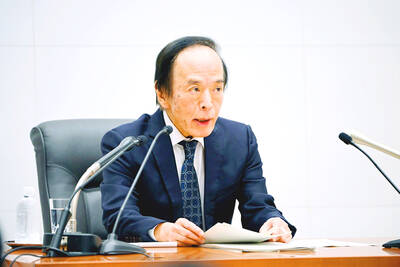India’s central bank kept interest rates on hold, while assuring markets of ample liquidity to manage the government’s near-record borrowing.
The Reserve Bank of India (RBI) is to sap some funds from banks by using the cash reserve ratio (CRR) — the amount of deposits that lenders must set aside as a reserve — as a tool and to use the money for more targeted market operations, Governor Shaktikanta Das said yesterday.
The bank’s Monetary Policy Committee separately decided to keep the repurchase rate unchanged at 4 percent.

Photo: Reuters
A previous CRR cut of 100 basis points to boost liquidity to fight the economic fallout of the COVID-19 pandemic is to be rolled back in two phases by May, Das said.
The cash is now to return to the central bank as reserves, allowing the RBI to, in turn, use it for open market operations and other liquidity measures, although Das did not specifically name any such programs.
“The RBI stands committed to ensure the availability of ample liquidity in the system and thereby foster congenial financial conditions for the recovery to gain traction,” Das said, stopping short of announcing specific measures.
Markets were disappointed by this lack of detail, especially regarding debt purchases by the RBI.
The yield on benchmark government bonds rose 5 basis points to 6.12 percent after climbing as high as 8 points.
The benchmark S&P BSE Sensex erased gains and was trading down 0.1 percent. The rupee strengthened 0.1 percent.
“The RBI is gradually withdrawing crisis time policies,” Nirmal Bang Equities Pvt economist Teresa John said. “Accommodative policy is here to stay and the RBI will act to prevent any sharp spike in yields.”
The central bank’s six-member panel also voted to retain its easy monetary policy stance for as long as is necessary to support growth, Das said.
The RBI, which last year lowered borrowing costs by 115 basis points, has been on pause since the middle of last year over inflation worries.
Although inflation is back in the RBI’s comfort range, higher government spending risks stoking price pressures and complicating the central bank’s efforts to resume policy easing.
Retail inflation eased to 4.6 percent in December last year, marking the first time in nine months that the headline rate returned within the RBI’s target band of 2 to 6 percent. That nudged the RBI to lower its inflation forecast — to 5.2 percent in the current quarter from 5.8 percent seen previously.
The RBI also upgraded its growth forecasts. It sees growth in the year starting April at 10.5 percent from an estimated 7.7 percent contraction in the current fiscal year.
That is slightly lower than the government’s 11 percent estimate and comes amid early signs of a recovery gaining momentum.
Indian Minister of Finance Nirmala Sitharaman on Monday unveiled a budget of almost US$500 billion to revive growth hurt by the COVID-19 pandemic.
The plan, which would rely on borrowing 12 trillion rupees (US$165 billion) to spend on healthcare and creating capital assets, would keep the budget deficit at a wider-than-expected 6.8 percent of GDP in fiscal year 2022.
“Monetary policy will continue to complement the expansionary fiscal policy through FY22, given the size of the borrowing program,” QuantEco Research founder Shubhada Rao said. “A balancing act may be needed in the second half of the financial year, as inflation is likely to creep up.”

Taiwan’s long-term economic competitiveness will hinge not only on national champions like Taiwan Semiconductor Manufacturing Co. (TSMC, 台積電) but also on the widespread adoption of artificial intelligence (AI) and other emerging technologies, a US-based scholar has said. At a lecture in Taipei on Tuesday, Jeffrey Ding, assistant professor of political science at the George Washington University and author of "Technology and the Rise of Great Powers," argued that historical experience shows that general-purpose technologies (GPTs) — such as electricity, computers and now AI — shape long-term economic advantages through their diffusion across the broader economy. "What really matters is not who pioneers

In a high-security Shenzhen laboratory, Chinese scientists have built what Washington has spent years trying to prevent: a prototype of a machine capable of producing the cutting-edge semiconductor chips that power artificial intelligence (AI), smartphones and weapons central to Western military dominance, Reuters has learned. Completed early this year and undergoing testing, the prototype fills nearly an entire factory floor. It was built by a team of former engineers from Dutch semiconductor giant ASML who reverse-engineered the company’s extreme ultraviolet lithography (EUV) machines, according to two people with knowledge of the project. EUV machines sit at the heart of a technological Cold

TAIWAN VALUE CHAIN: Foxtron is to fully own Luxgen following the transaction and it plans to launch a new electric model, the Foxtron Bria, in Taiwan next year Yulon Motor Co (裕隆汽車) yesterday said that its board of directors approved the disposal of its electric vehicle (EV) unit, Luxgen Motor Co (納智捷汽車), to Foxtron Vehicle Technologies Co (鴻華先進) for NT$787.6 million (US$24.98 million). Foxtron, a half-half joint venture between Yulon affiliate Hua-Chuang Automobile Information Technical Center Co (華創車電) and Hon Hai Precision Industry Co (鴻海精密), expects to wrap up the deal in the first quarter of next year. Foxtron would fully own Luxgen following the transaction, including five car distributing companies, outlets and all employees. The deal is subject to the approval of the Fair Trade Commission, Foxtron said. “Foxtron will be

INFLATION CONSIDERATION: The BOJ governor said that it would ‘keep making appropriate decisions’ and would adjust depending on the economy and prices The Bank of Japan (BOJ) yesterday raised its benchmark interest rate to the highest in 30 years and said more increases are in the pipeline if conditions allow, in a sign of growing conviction that it can attain the stable inflation target it has pursued for more than a decade. Bank of Japan Governor Kazuo Ueda’s policy board increased the rate by 0.2 percentage points to 0.75 percent, in a unanimous decision, the bank said in a statement. The central bank cited the rising likelihood of its economic outlook being realized. The rate change was expected by all 50 economists surveyed by Bloomberg. The